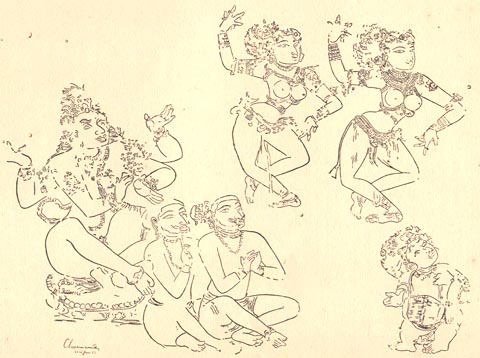
Painting and Natya
BY C. SIVARAMAMURTHY, B.A. (HONS.)
A picture is a moMent of natya. And natya is a series of pictures. Whether it is the Depiction of human emotions and actions, or a representation of the frisking of animals, or a portrayal of the leaves of trees rustling in the wind, or the play of the ripples in a silvery lake, the picture is all the same a mirror of one moment of some aspect of Nature's natya. The Vishnudharmottara; one of the oldest works on painting in India, voices this opinion in the slokas :
Yatha nritte tatha chitre trailokyanukritis smtita!
Drishtayascha tatha bhava angopangani sarvasah!!
Karascha ye maha (maya?) nritte purvokta nrpasattama!
Ta eva chitre vijneya nrittam chitram param matam!!
This connection between painting and natya has been specially reiterated by poets in Sanskrit literature. A splendid body possessing a beautiful form and graceful gait being the essential requisite in the case of a dancer, Kalidasa gives it in verse:
Dirghaksham saradindukanti vadanam bahu natavamsayoh
Samkshiptam nibidonnatastanamurah parsve pramrishte iva!
Madhyah panimito nitambi jaghanam padavaralanguli
Cchando nartayituryathaiva manasas slishtam tathasya vapuh!!
-Malavikagnimitra Act II. 3
The various ‘sthanas’ and ‘karanas’ so important in natya are as essential in ‘chitra,’ wherein beauty of pose is as important as beauty of form. Ratnakara, the author of the gigantic work Haravijaya, speaks of this connection between ‘chitra’ and natya in the verse:
Vichitrasthanakopetah sukumarangavartanah!
Nritte chitre cha dadatimakshiptahridayas striyah!!
–XXXIII. 3
This interrelation between ‘chitra’ and natya is best brought home to our mind by a look at practical examples like the ancient frescoes at Ajanta, Bagh and other places. A beautiful example of fresco dealing with natya is to be found in the picture of the danseuse on the walls of Sri Brihadisvara temple at Tanjore, given below:
